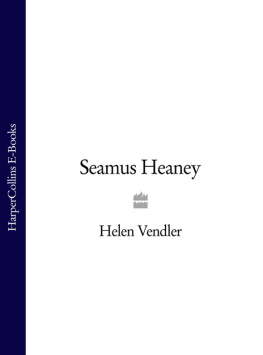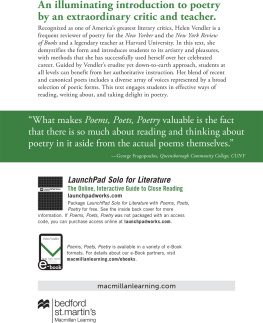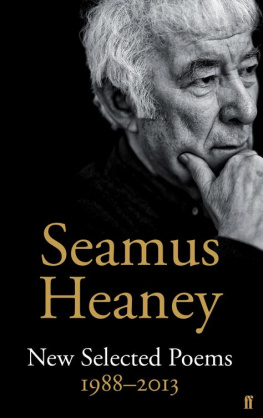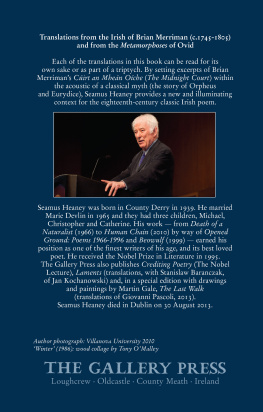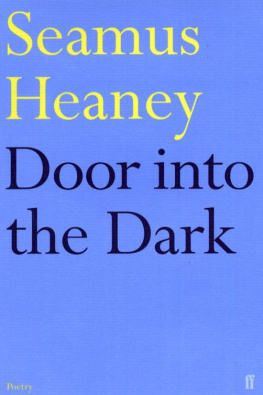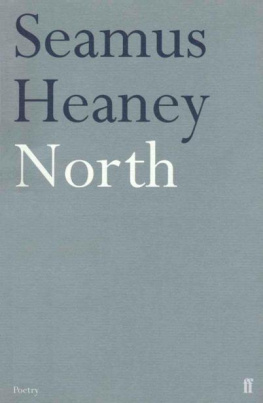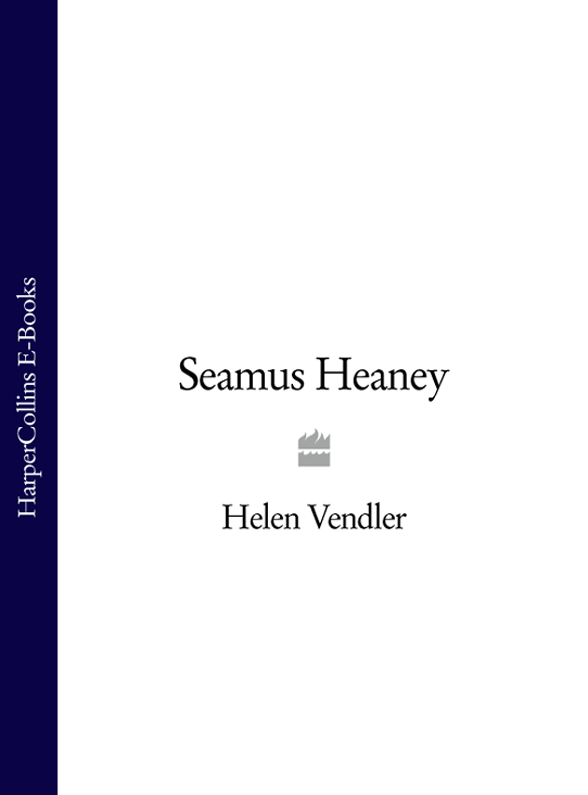W. B. YEATS
CONTENTS
Reality is not simply there, it must be sought for and won.
P AUL C ELAN, in answer to a questionnaire from the
Librairie Flinker
In the following pages, I trace Seamus Heaneys development as a poet from 1966 to 1996. It was in 1995 that Heaney (who was born in 1939 in Northern Ireland) was awarded the Nobel Prize for this body of work, composed during what he called, in his Nobel Lecture, a quarter century of life waste and spirit waste (CP, 24). Heaney was referring to daily life in Northern Ireland, disturbed by internal strife since the late 1960s. The Catholic civil rights marches of the sixties (protesting discrimination in jobs and housing, and gerrymandering of political districts), followed by police repression, led to disturbances that the Ulster government attempted to quell in 1971 by the internment without trial of thousands of citizens; in 1972 the (British) army killing of fourteen unarmed Catholic marchers on Bloody Sunday provoked direct rule of Northern Ireland from Westminster. Terrorist actions on the part of both the Provisional IRA and the Ulster paramilitaries escalated, and though motions towards a cessation of violence have been put forward since 1994, a permanent ceasefire is not yet securely in place. These conditions forced Heaney (who had been raised a Catholic) into becoming a poet of public as well as private life.
Heaneys poetry has reached a large public in Ireland and abroad, and that public extends to all classes. It is a poetry in which readers can recognize profound family affections, eloquent landscapes, and vigorous social concern. It tells an expressive autobiographical story reaching from boyhood to Heaneys present age of sixty, a story which includes a childhood at home with parents, relatives, siblings; an adolescence with schoolfellows and friends; an adulthood with a marriage and children; a displacement from Northern Ireland to the Republic; travels; sorrows and deaths. As each decade of poetry unfolds, it illuminates and corrects the previous ones. Within its autobiographical circuit, it is also an oeuvre of strong social engagement, looking steadily and with stunning poetic force at what it means to be a contemporary citizen of Northern Ireland at the intolerable stresses put on the population by conflict, fear, betrayals, murders. Heaney has made one imaginative cast after another in an attempt to represent the almost unrepresentable collective suffering of the North, yet he has tried, equally consistently, to bring intellectual reflection to the emotional attitudes that too often yield the binary position-taking of propaganda.
These would seem to be the achievements of Heaneys poetry; and most of his readers, if asked, would cite the autobiographical and the political as aspects drawing them to his poems. But these thematic elements do not by themselves make for memorable poetry, and the powerful symbols Heaney has found for his poetry are responsible for much of its effect. His commentators find themselves talking not merely of but within those powerful symbols the exhumed bog bodies in North, the Lough Derg pilgrims in Station Island, the political parables of frontiers and islands in The Haw Lantern. Heaney has made out of his symbols a shorthand for his era. Yet even adequately-imagined symbols do not suffice for memorable work: poetry needs words and syntax as strikingly expressive as its themes and its symbols, and it also requires internal structures that act out the emotions they exist to convey. Heaneys language is unusually rich in simplicity as well as in ornateness, each where it suits; his syntax is sinuous and expressive, whether it is sternly terse or restlessly mobile; and his highly-developed sense of internal structure gives his poems a satisfying musical rightness as they unfold. Each of his volumes ambitiously sets itself a different task from its predecessors; each takes up a new form of writing; and just when one thinks one knows all of Heaneys possibilities of style, he unfurls a new one. His readers, even when they do not notice technique in any explicit way, are being persuaded into the poem by words, by syntax, by structures, as well as by themes and symbols. Feeling into Words, the title of an early essay by Heaney, can be taken as the motto for all his work
My own acquaintance with Heaneys work began in 1975. I was lecturing at the Yeats School in Sligo in the summer of that year, and at the schools annual poetry reading a young man in his thirties named Seamus Heaney, wholly unknown to me, stood at the lectern and read some of the most extraordinary poems I had ever heard. I approached him afterwards, and asked whether these poems were to appear soon in a book as I wanted to write about them. Heaney replied that in fact he had galleys with him, and lent them to me. They were the galleys of North, which I thought then and still think now one of the crucial poetic interventions of the twentieth century, ranking with Prufrock and Harmonium and North of Boston in its key role in the history of modern poetry.
I reviewed North for the New York Times Book Review a few months later, and have been writing about Heaney ever since. My startled and wholehearted response on first encountering Heaneys writing was by no means unique: his poetry has now been translated and appreciated all over the world, and the Nobel is only one of several foreign prizes (in addition to many from English-speaking countries) awarded to his work. The purpose of this book is to explain, as much to myself as to others, the power of his extraordinary poetry. It derives as all poetry does from the inspiration of predecessors, and the most important of these for Heaney have been (in the English/Irish/American tradition) the Beowulf-poet, the anonymous author of the Middle Irish poem Buile Suibhne, William Wordsworth, John Keats, Gerard Manley Hopkins, W. B. Yeats, James Joyce, Robert Frost, Patrick Kavanagh and Ted Hughes. Among classical poets, one should mention Aeschylus and Virgil; among foreign poets, Dante, Osip Mandelstam and Zbigniew Herbert. Heaney has written about many of these authors in his essays on poetry; and scholars have begun to trace specific instances of intertextual connections in Heaneys poetry. I cannot for reasons of space treat influence here, but Heaney is among the most learned of contemporary poets, and has brought together influences not often found conjoined in creating his own unmistakable style.
Nor can I describe, here, the generational context in which Heaney appears, though I can at least list a portion of it, giving the more celebrated names. Heaney was preceded by John Hewitt, John Montague and Thomas Kinsella, and fellowed by Seamus Deane, Michael Longley and Derek Mahon. He has been followed by (among others) Tom Paulin, Paul Muldoon, Medbh McGuckian and Ciaran Carson. Each of these poets some Protestant, some Catholic, some Northern, some Southern has brought a distinctive voice to the second half of the twentieth century in Ireland; each has also been part of a new wave of Irish writing of linguistic variety and imaginative depth. Literary historians have already begun to chart this period, and literary critics to dispute positions concerning it. Heaneys influence on his successors has been almost as intimidating as Yeatss influence on those coming after him; but successful flanking motions have been invented in Paulins grittiness of surface, Muldoons enigmatic comedy, McGuckians stream-of-consciousness imagery, and Ciaran Carsons long urban line.

